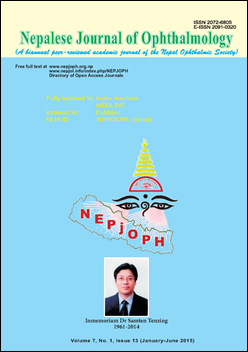Systemic association of newly diagnosed proliferative diabetic retinopathy among type 2 diabetes patients presented at a tertiary eye hospital of Nepal
DOI:
https://doi.org/10.3126/nepjoph.v7i1.13163Keywords:
proliferative diabetic retinopathy, microalbuminuria, lipid pro¿le, hypertension, proteinuriaAbstract
Introduction: Proliferative diabetic retinopathy (PDR) is the leading cause of blindness among the diabetics.
Objective: to study the systemic association of proliferative diabetic retinopathy.
Materials and methods: A prospective, case-series study was conducted among the newly diagnosed proliferative diabetic retinopathy cases presenting at the Tilganga Institute of Ophthalmology (TIO) from January 2012 to January 2013. Diabetic retinopathy was classi¿ed using the Early Treatment Diabetic Retinopathy Study criteria. Blood pressure, fasting and postprandial blood sugar, glycosylated hemoglobin, lipid pro¿le, urine for microalbumin, urea, and creatinine were evaluated at the time of diagnosis.
Results: A total of 104 type 2 diabetic patients with newly diagnosed PDR presented during the study period. Concurrent macular edema was present in 93 cases (89.42 %). The mean age was 56.96 ± 9.394 (range 32 - 78) years. Males and females comprised of 75.7 % and 24.3 % respectively. The majority (37.5 %) were involved in business, followed by government service (17.30 %), and housewives (16.34 %). Mean duration of diabetes was 11.42 ± 5.356 years (range 1 month - 26 years). Concurrent hypertension was found in 55.76 %, uncontrolled fasting and or postprandial blood sugar in 72.54 %, poor glycemic control (HbA1C > 7 %) in 73.97 %, abnormal lipid profile in 52.56 %, microalbuminuria in 67.85 %, and positive urine albumin in 50 % of the cases.
Conclusion: Despite the short duration of diabetes, the concurrent hypertension, poor glycemic control, proteinuria and dyslipidemia were the main systemic associations for PDR at our clinical set-up. Awareness, identification and management of these systemic problems could reduce the rapid progression to PDR.
Downloads
Downloads
Published
How to Cite
Issue
Section
License
This license enables reusers to copy and distribute the material in any medium or format in unadapted form only, for noncommercial purposes only, and only so long as attribution is given to the creator.




